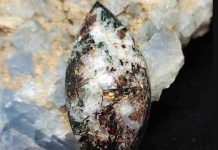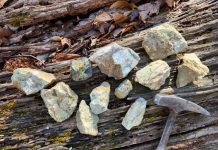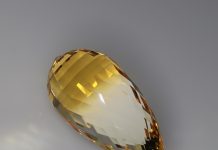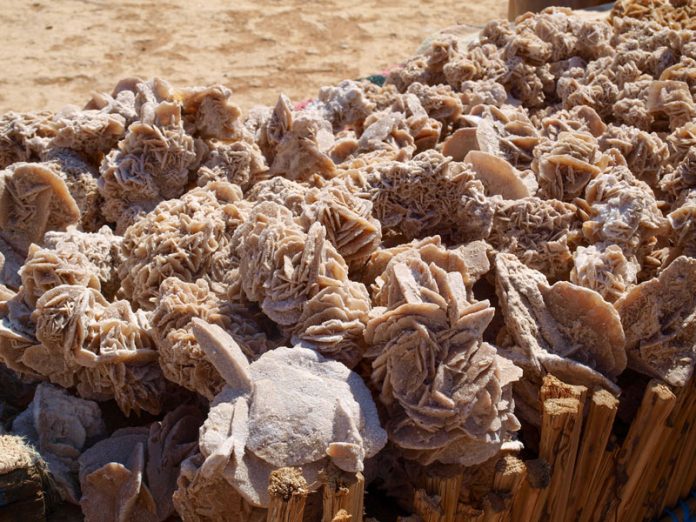
Desert rose rocks are to February what pumpkins are to October. If you really want to make a lasting impression, consider a 250 million-year-old barite rose, guaranteed never to lose its bloom, and whose natural rarity will assure the one you love that you find them pretty special, too.
Fossil lovers might appreciate that some of the first traces of rose have been discovered at Colorado’s Florissant Fossil Beds and date back to some 40 million Eocene years ago.

Desert Rose Rocks by any Other Name
Collectors covet barite rose because its unique formation only appears — in significant quantity — along a vein of central Oklahoman red sandstone called the Barite Rose Belt. Other rock-collecting opportunities in Oklahoma, like where to find agates, can make collecting in this state fruitful. Just make sure to check is it legal to collect rocks where you are visiting. Smaller clusters of desert rose rocks have been identified in Kansas and outside the United States in Australia and Morocco. Coral-colored (rather than red) barite rose has also been unearthed in California, Texas and Egypt.

According to the Oklahoma Geological Survey (OGS) established in 1908 at the University of Oklahoma, “few mineral specimens are as distinctly recognizable and traceable to source” as barite roses, also known as rose rocks, desert roses and “Oklahoma walnuts.”
The colloquial reference to such crystal clusters as rose rocks is more romanticized than accurate. Barite roses are mineral specimens, not rocks, as one of its most devoted geological gardeners, David London (now retired) with ConocoPhillips School of Geology and Geophysics at the University of Oklahoma in Norman cited in his The Barite Roses of Oklahoma, published in the July-August 2008 Volume 39, Issue 34, of The Mineralogical Record.
“The classification [as minerals] is correct,” he wrote, “because the shapes of rocks are indeterminate, whereas the shapes of minerals are determined by a combination of forms and habits derived from the interplay of crystal structure and environment of growth.”
“Unfortunately,” London said, “the barite rose became the official state rock of Oklahoma when House Bill 1277 was signed into law in 1968. Noble, Oklahoma, was made the official rose rock capital (of Oklahoma, and by default, the world) via an act of the Oklahoma House of Representatives in 1983. Oklahoma now has an official state crystal (the hourglass sand gypsum crystals from the Salt Plains Wildlife Refuge), as signed into law in 2005, but no state mineral.
“The barite rose,” the author and geologist quipped, “would have been a fitting candidate for that distinction.”
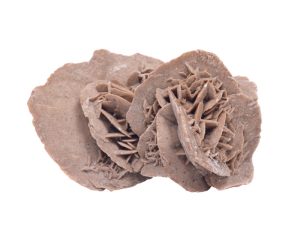
More Mystery Than Thorns
Barite rose enthralls collectors and baffles geologists. It likes to run in veins where just a few square feet of sandstone can yield thousands of clusters. Yet when such natural gardens run dry, blooms may not appear again for miles.
“Mama nature does good,” Noble native and longtime rock hunter Tom Redwine said more than a decade ago to Jennifer L. Brown with The Oklahoman newspaper, after having uncovered one of the largest rose clusters ever found, a 788-pound bouquet he nicknamed “Redwine & Roses” before selling it for nearly $10,000 to a buyer in Ardmore.
The majority of scientific presumptions hold that barite rose formed as water moved through sandstone at around the same time as deposits for another Oklahoma configuration, the Garber Formation. Albeit London still observed that a precise origin is still “somewhat of an enigma.”
“Barite roses were deposited in fractures and along porous horizons within the Garber Sandstone sometime after it lithified (turned to rock),” cites OGS, which reprinted London’s work on rose rocks, while adding, “The exact age is not known and the roses could still be growing.”
Permian (i.e., late Paleozoic) red sandstone like the Garber is common throughout the world and yet, OGS notes, “Barite roses are extremely rare. The origin of the roses, therefore, does not result from the depositional environment of the sandstone, but stems from some other uncommon feature of Oklahoma’s geology.”
An attraction to these enigmatic roses becomes all the more compelling because, to its knowledge, OGS still says no scientist has completely understood what controls the distribution of barite rose or how exactly they form.

Let’s Get Geological
Symbolically, a light red rose flower is connected with love at first sight, that instantaneous attraction that ignites when we see something so compelling we are drawn to know more about it.
What we do know, geologically, about barite rose includes how they consist of radial and rosette “sprays” of disc-shaped barite, or baryte (BaSO4) crystals, containing angular, medium quartz (SiO2) sand derived from the geologic formation known as the Garber Sandstone; small quantities of hematite (Fe2O3) provide the reddish hue.
Each “rose” reflects the shape of barite crystals, carried by groundwater containing barium and sulfide, into fractures and porous layers of quartz sand in the Garber Sandstone. One theory posits that sulfur in the groundwater, once aerated, oxidized from sulfide to sulfate, leading to the precipitation of the otherwise “extremely insoluble in natural waters” barite.
Another more “you-got-peanut-butter-inmy-chocolate” possibility suggests separate sources of barium- and sulfate-infused waters mixed together while flowing through the Garber Sandstone, resulting in the rock lover’s equivalent of a Reese’s Peanut Butter Cup: barite rose.
Each “petal” is a single crystal barite and what makes them unique is the shape. “The best explanation to date,” OGS says, “is that the barite grew in the presence of organic compounds that stunted growth at the corners of the crystals, leading to the rounded shape.”

Desert Rose Blooms That Last
If there was a “heyday” for unfettered barite rose to collect, London surmises in his mineralogical record, it was probably from the 1940s to 1960s when Oklahoma property owners like Tom Blair, J.C. Hailey, Pete Peters, and Frank Shobert, harvested and sold crops of crystals – some at the price of potatoes – until the best localities were mined out and/or closed to the public.
Today, it’s not just the wind that comes sweepin’ down the plain in Oklahoma. Wholesale and supply services offer a geologic garden of delights, from luscious single barite rose in bloom to clustered bouquets of crystals.
Like Mackenzie Summers, whose Happy Hound Rose Rocks in Norman, proudly touts offering the largest – in selection and size – barite rose crystals on the planet. Summers, a truck and heavy equipment operator who calls finding and selling large barite roses her side gig, can back that claim up. In August 2021, after some heavy earth moving, she got permission from the landowner to take a look and see what may have been uncovered.
Her story starts like that of many a rock hunter: “I saw a little corner sticking out of the dirt.”
That little corner turned out to be a single, not cluster, barite rose measuring 17” x 24” and weighing more than 120 pounds. It took three people to lift the mighty mineral into her truck bed.
“When I realized it was, for sure, a rose rock, I was really excited. I thought, Oh my gosh, we have to celebrate!” Happy Hound Rose Rocks and images of its blooming discoveries can be found on Facebook.
Other online resources include Ron Coleman Mining & Crystal Digging with barite rosettes for as little as $2 each (just don’t let your Valentine know they were a cheap date), and Spirit Rock Shop which stocks both gypsum selenite desert roses and barite Oklahoma roses from the private collection of a lifelong enthusiast, L. Shearer.
“He spent the last 60 years of his life collecting and selling these wonderful, well-formed barite roses,” described SpiritRock Shop founders, Dan and Chris Edwards. “He called them ‘the flowers of the mineral kingdom.”
This story about desert rose rocks previously appeared in Rock & Gem magazine. Click here to subscribe! Story by L.A. Sokolowski.



